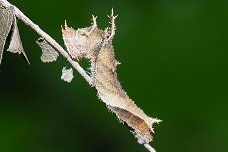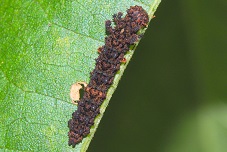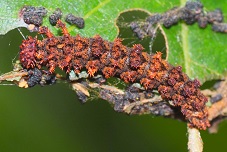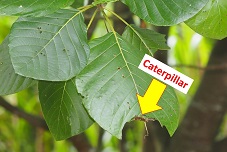| Home | Nature Weekly Index |
5 April 2020 | Catepillars and Host Plants |
Over the last 3 months, I was able to locate 2 species of caterpillars in a park with ease on their host plants despite their advance camouflaging mechanism. There were few commonalities between the 2 caterpillars. One that stood out was their approach in chewing up the leaves; both of began feeding from the distal tip of the leaf and work their way inward. On top of that, they rarely consumed the entire leaf.


 The first caterpillar was from the butterfly,
Short Banded Sailor (Phaedyma columella singa).
This is a relatively small caterpillar which I managed to locate it at 2 occasions in February and March
respectively on 2 different, Andira inermis (Cabbage Tree)
Their size was so small that the likelihood of finding them by chance is very low, which was the main reason
that I had never seen one in the past. Imagine the vast vegetation around you when you walk in the park. It was
hard to find a creature around a centimetre long. Once I understood its feeding pattern and host plant, the
chance of finding them increase significantly. Its host plant, Cabbage Tree is a very common tree species in the
park. Interestingly, it was not one of the host plants reported in the
Butterfly Circle website. Instead, it is
indicated as the
host plant for another butterfly,
Singapore Fourline Blue (Nacaduba pavana singapura).
The first caterpillar was from the butterfly,
Short Banded Sailor (Phaedyma columella singa).
This is a relatively small caterpillar which I managed to locate it at 2 occasions in February and March
respectively on 2 different, Andira inermis (Cabbage Tree)
Their size was so small that the likelihood of finding them by chance is very low, which was the main reason
that I had never seen one in the past. Imagine the vast vegetation around you when you walk in the park. It was
hard to find a creature around a centimetre long. Once I understood its feeding pattern and host plant, the
chance of finding them increase significantly. Its host plant, Cabbage Tree is a very common tree species in the
park. Interestingly, it was not one of the host plants reported in the
Butterfly Circle website. Instead, it is
indicated as the
host plant for another butterfly,
Singapore Fourline Blue (Nacaduba pavana singapura).


 The second caterpillar was from the butterfly,
Commander (Moduza procris milonia).
The first sighting was in December 2019 on the leaf of
Timonius wallichianus (Silver Timon), one of its
reported host plant. I did not pay much attention then, treating it as another sighting by chance. In January
this year, I found 3 caterpillars on the leaves of a
Guettarda speciosa (Beach Gardenia) tree in the park.
In subsequent months, I continued to see caterpillars on this tree most of the time. This tree has leaves larger
than the size of a human hand but it is not a host plant reported in the
Butterfly Circle website. Compared to
the Cabbage Tree which grew in the wild, there were fewer Beach Gardenia trees and they were mostly likely
planted by NParks. Similarly, knowing the feeding pattern of the caterpillar and its host plant made it easier
to locate the caterpillars.
The second caterpillar was from the butterfly,
Commander (Moduza procris milonia).
The first sighting was in December 2019 on the leaf of
Timonius wallichianus (Silver Timon), one of its
reported host plant. I did not pay much attention then, treating it as another sighting by chance. In January
this year, I found 3 caterpillars on the leaves of a
Guettarda speciosa (Beach Gardenia) tree in the park.
In subsequent months, I continued to see caterpillars on this tree most of the time. This tree has leaves larger
than the size of a human hand but it is not a host plant reported in the
Butterfly Circle website. Compared to
the Cabbage Tree which grew in the wild, there were fewer Beach Gardenia trees and they were mostly likely
planted by NParks. Similarly, knowing the feeding pattern of the caterpillar and its host plant made it easier
to locate the caterpillars.